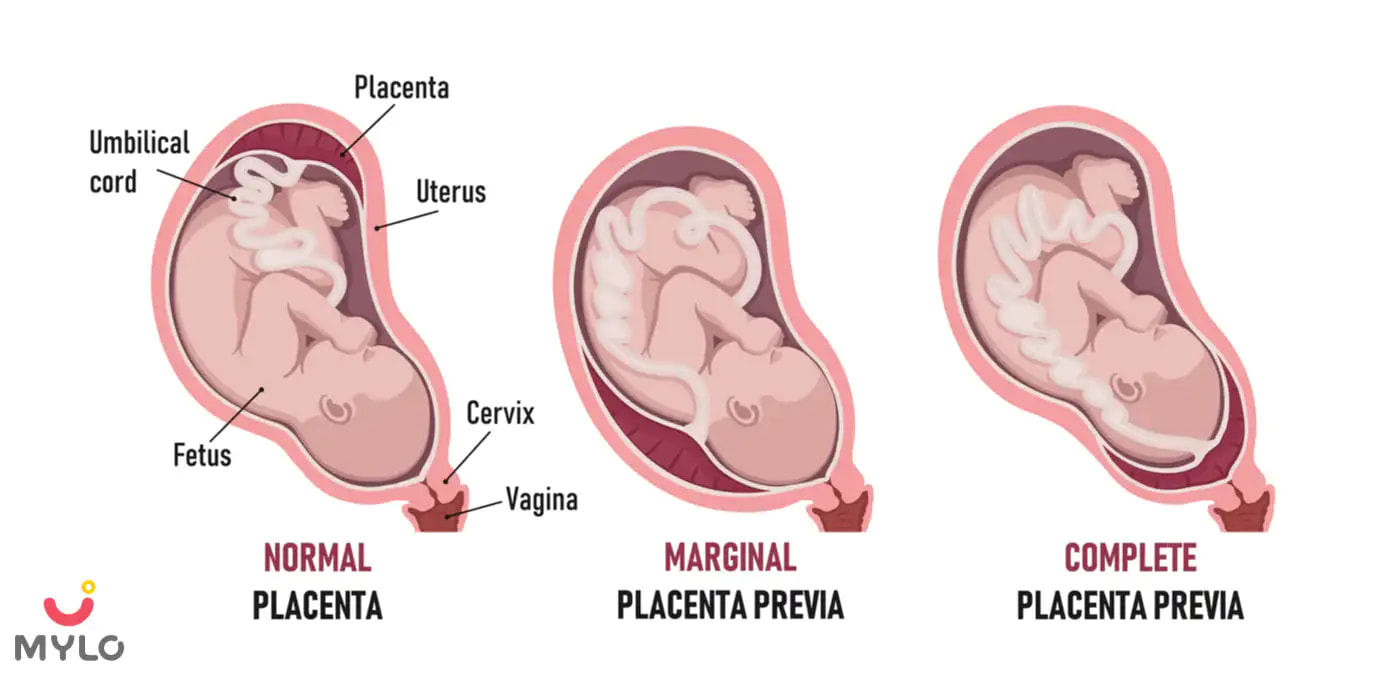Home

Low Lying Placenta

Low Lying Placenta Precautions: How to Protect Yourself and Your Baby
In this Article

Low Lying Placenta
Low Lying Placenta Precautions: How to Protect Yourself and Your Baby
Updated on 3 November 2023
Pregnancy is an extremely delicate time wherein a woman must brave the risk of complications and protect herself and her little one. One of the most common complications during pregnancy is a low-lying placenta, which occurs when the placenta attaches itself to the lower part of the uterus. In this article, we will explore some low lying placenta precautions that expectant mothers should take to protect themselves and their babies.
What is Low Lying Placenta?
Normally, the placenta starts developing wherever the fertilized egg is implanted in the uterine wall during the initial weeks of pregnancy. It begins to grow around the womb. A low lying placenta means that it covers the cervix either entirely or partially. While it can move upwards and away from the cervix as the uterus grows, sometimes it remains in the lower position across the duration of the pregnancy. It can be identified through an ultrasound test or a transvaginal ultrasound during a routine prenatal checkup or after a vaginal bleeding incident.
After being diagnosed with a low lying placenta, the doctor will recommend the expecting mother some precautions for low lying placenta to ensure that her pregnancy progresses safely.
Causes of Low Lying Placenta and Placenta Previa
It's normal to wonder what is the reason for low lying placenta if you have been diagnosed with it. Here are possible causes of low lying placenta during pregnancy:
1. Maternal Age
According to the International Journal of Medical Research and Review (IJMRR), women above 35 are 3.6% more likely to have a low lying placenta. Women under 20 and above 30 are more susceptible to placenta previa. Also, IVF increases the risk of placental issues.
2. Unusual Foetus Position
Under normal circumstances, as the fetus develops, it naturally turns upside down to aid childbirth. However, an upright position of the baby can be a risk factor for a low lying placenta.
3. Complications during the first pregnancy
Not all second pregnancies experience symptoms of low lying placenta. However, any damage to the endometrium during the first pregnancy increases the risk of a low placenta, the second time. Placenta previa is more likely to occur in women who have already given birth once. Past C-sections that may have damaged the uterus are at higher risk.
4. Multiple pregnancies at a time
Multiple pregnancies can increase the risk of a low lying placenta and placenta previa because the uterus over-expands to carry multiple babies.
5. Lifestyle
Unhealthy lifestyle habits such as smoking and consuming drugs and alcohol may cause a low lying placenta and placenta previa. Smoking leads to placental hypertrophy - an abnormally heavy placenta - making it difficult for the placenta to move upwards.
Low Lying Placenta Precautions
Now that we know what a low lying placenta means and the reasons behind it, here are some precautions for low lying placenta that can help you reduce the risk of any complications and ensure the wellbeing of your baby during pregnancy:
1. Avoid sexual intercourse
If you have a low-lying placenta that blocks the opening to your cervix or causes bleeding, you should avoid penetrative sex. This is because sexual intercourse can increase the risk of bleeding.
2. Bed rest, if prescribed
If the low-lying placenta is close to the edge of the cervix or you have placenta previa, your doctor may recommend you bed rest during pregnancy. This can help minimise any exertions to the body and prevent bleeding and premature labor.
3. Avoid lifting heavy objects
Not lifting any heavy objects is among the low lying placenta precautions in second trimester. This is because lifting heavy things can put pressure on the cervix and cause vaginal bleeding, which can be dangerous for both the mother and the baby.
4. Consume iron-rich foods
Low levels of iron along with low lying placenta during pregnancy can restrict blood flow to the fetus and cause problems in fetal growth and development and other complications. Iron-rich foods such as spinach, broccoli, kale, salmon, and lentils can sustain a healthy placenta and prevent iron-deficiency anemia.
5. Monitor for symptoms
If you have been diagnosed with low lying placenta, it is important to be on the look out for certain symptoms such as bleeding, contractions, or pain as they could indicate a complication. If you notice any of these symptoms, you should immediately contact your doctor.
6. Avoid strenuous exercise
If you have a low-lying placenta during pregnancy, it is important to limit or avoid exercise depending on the location of the placenta and how far along the pregnancy is. Strenuous exercise may increase pressure down on the cervix, which can pose a risk to both the mother and baby.
You may also like: When to Make an Emergency Doctor Visit During Pregnancy?
7. Follow the doctor's instructions
When it comes to low lying placenta precautions, nobody can advise you better than your doctor. It is essential for your and your baby's wellbeing to take yoir doctor's word religiously and follow their recommendations for a safe and healthy pregnancy.
8. Attend all prenatal appointments
Attending all prenatal appointments is crucial if you have a low-lying placenta or placenta praevia. During these appointments, your healthcare provider will monitor the position of your placenta and the health of your baby. In addition, your healthcare provider will discuss birthing options with you and recommend early delivery if bleeding occurs before the due date.
Giving Birth with a Low Lying Placenta: C-Section or Vaginal Delivery?
Women with a low-lying placenta do not necessarily need to have a C-section delivery, even if the placenta is 0 to 10mm from the cervix. However, there is a greater likelihood of an emergency C-section. This is because in case a woman experiences bleeding before her due date, the doctor will most likely perform an emergency C-section to ensure her and her baby's wellbeing. That being said, it's possible that you may have a normal delivery with low lying placenta. For best results, it's important to follow all the precautions for low lying placenta recommended by your doctor.
FAQs
1. What are some low lying placenta precautions in second trimester?
Some low-lying placenta precautions in the second trimester include avoiding lifting heavy objects, staying on bed rest if there is heavy bleeding, and contacting a doctor if there is any bleeding, contractions, or pain.
2. What are some posterior low lying placenta precautions?
Some important precuations for posterior low lying placenta include avoiding sexual intercourse, not lifting heavy objects, consuming iron-rich foods, following regular prenatal care and consultations and contact your doctor immediately if you experience any bleeding, contractions, or pain.
Closing Thoughts
In conclusion, having a low-lying placenta during pregnancy can be concerning, but there are many low lying placenta precautions that can be taken to help ensure the safety of both mother and baby. With proper care and attention, the majority of women with a low-lying placenta go on to have healthy, full-term pregnancies and deliver healthy babies. Remember to stay positive and focus on the many joys of pregnancy, and know that you are doing everything in your power to give your baby the best possible start in life.
References
- Oppenheimer LW, Farine D, Ritchie JW, Lewinsky RM, Telford J, Fairbanks LA. (1991). What is a low-lying placenta?
- Jauniaux, ERM, Alfirevic, Z, Bhide, AG, et al. (2018). Placenta Praevia and Placenta Accreta: Diagnosis and Management.



Written by
Priyanka Verma
Priyanka is an experienced editor & content writer with great attention to detail. Mother to an 11-year-old, she's a ski
Read MoreGet baby's diet chart, and growth tips

Related Articles
RECENTLY PUBLISHED ARTICLES
our most recent articles

Diet & Nutrition
গর্ভাবস্থায় আলুবোখরা: উপকারিতা ও ঝুঁকি | Prunes During Pregnancy: Benefits & Risks in Bengali

Diet & Nutrition
গর্ভাবস্থায় হিং | ঝুঁকি, সুবিধা এবং অন্যান্য চিকিৎসা | Hing During Pregnancy | Risks, Benefits & Other Treatments in Bengali

Women Specific Issues
স্তনের উপর সাদা দাগ: লক্ষণ, কারণ এবং চিকিৎসা | White Spots on Nipple: Causes, Symptoms, and Treatments in Bengali

Diet & Nutrition
গর্ভাবস্থায় পোহা: উপকারিতা, ধরণ এবং রেসিপি | Poha During Pregnancy: Benefits, Types & Recipes in Bengali

Diet & Nutrition
গর্ভাবস্থায় মাছ: উপকারিতা এবং ঝুঁকি | Fish In Pregnancy: Benefits and Risks in Bengali

Diet & Nutrition
গর্ভাবস্থায় রেড ওয়াইন: পার্শ্ব প্রতিক্রিয়া এবং নির্দেশিকা | Red Wine During Pregnancy: Side Effects & Guidelines in Bengali
- ইনার থাই চ্যাফিং: কারণ, উপসর্গ এবং চিকিৎসা | Inner Thigh Chafing: Causes, Symptoms & Treatment in Bengali
- গর্ভাবস্থায় ব্রাউন রাইস: উপকারিতা ও সতর্কতা | Brown Rice During Pregnancy: Benefits & Precautions in Bengali
- Velamentous Cord Insertion - Precautions, Results & Safety
- Unlock the Secret to Flawless Skin: 7 Must-Have Qualities in a Face Serum
- Unlock the Secret to Radiant Skin: How Vitamin C Serum Can Transform Your Complexion
- Gender No Bar: 10 Reasons Why Everyone Needs a Body Lotion
- Unlock the Secret to Radiant Skin How to Choose the Perfect Body Lotion for Your Skin Type
- Top 10 Reasons to Apply a Body Lotion After Every Bath
- Communication in Toddlers: Milestones & Activities
- How to Improve Vocabulary for Toddlers?
- A Comprehensive Guide to Understanding Placenta Accreta
- Vulvovaginitis in Toddlers Causes, Symptoms and Treatment
- A Comprehensive Guide to Understanding Cerebral Palsy in Children
- Bitter Taste in Mouth During Pregnancy: Understanding the Causes and Remedies


AWARDS AND RECOGNITION

Mylo wins Forbes D2C Disruptor award

Mylo wins The Economic Times Promising Brands 2022
AS SEEN IN
















- Mylo Care: Effective and science-backed personal care and wellness solutions for a joyful you.
- Mylo Baby: Science-backed, gentle and effective personal care & hygiene range for your little one.
- Mylo Community: Trusted and empathetic community of 10mn+ parents and experts.
Product Categories
baby carrier | baby soap | baby wipes | stretch marks cream | baby cream | baby shampoo | baby massage oil | baby hair oil | stretch marks oil | baby body wash | baby powder | baby lotion | diaper rash cream | newborn diapers | teether | baby kajal | baby diapers | cloth diapers |








